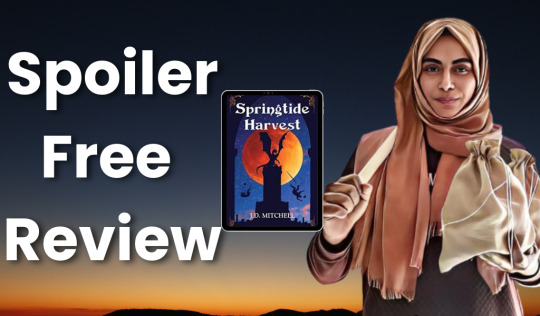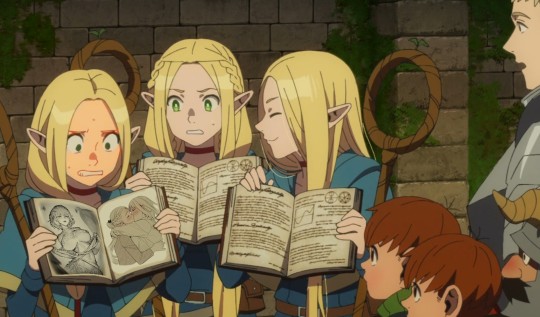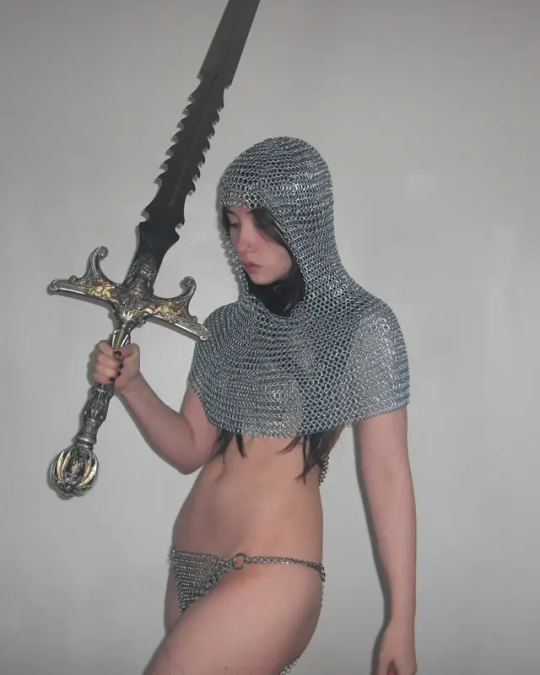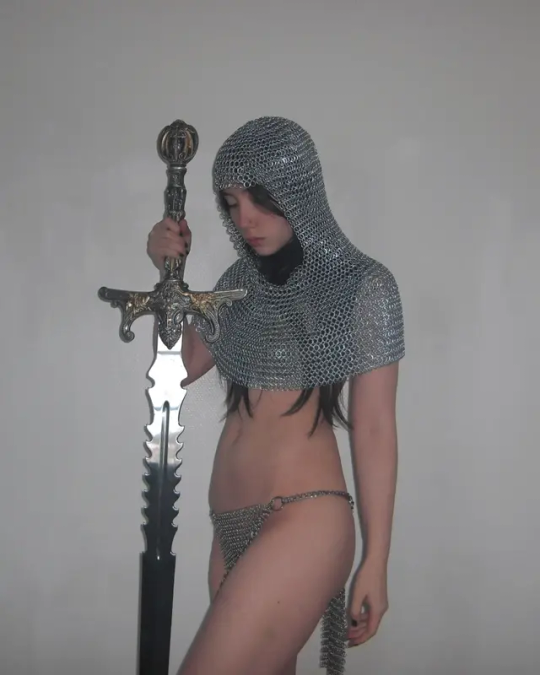#Sword And Sorcery Fantasy
Explore tagged Tumblr posts
Text
A Quest Style Coming-Of-Age Fantasy !! Springtide Harvest By JD Mitchell | Book Review
A Quest Style Coming-Of-Age Fantasy !! Springtide Harvest By JD Mitchell | Book Review
TITLE : Springtide Harvest AUTHOR : JD Mitchell GENRE : Fantasy, Sword And Sorcery Intended Age Group: Adult Pages: 418 DATE OF PUBLISHING : August 22, 2022 SYNOPSIS The old world is dead. Worse, it was a lie. Haskell yearns to be a warrior like his grandfather, who broke the orcish hordes, not the unwanted son of a ruthless High City merchant. With nothing but a bag of stolen coin and…

View On WordPress
#book blog#Book Blogger#Book Blogger India#Book Blogger UAE#Book Blogging#Book Recommendation#Book Review#Booktube REview#D&D inspired Fantasy#Fazila Reads#JD Mitchell Author#Non Spoiler Book Review#Springtide Harvest#Springtide Harvest Book Review#Springtide Harvest by JD Mitchell#Sword And Sorcery Fantasy#TBR
2 notes
·
View notes
Text

#Marcille Donato#マルシル・ドナトー#Marcille#マルシル#Dungeon Meshi#ダンジョン飯#Delicious in Dungeon#Tragones y mazmorras#Calabozos y tragones#Anime#Fantasy#Fantasy anime#Sword & Sorcery
9K notes
·
View notes
Note
Could I ask where dungeons of the kind in D&D came about? Like they’re a cultural icon now, but I don’t understand their origins very well
The dungeon crawl is a pretty standard trope in 1960s and 1970s sword and sorcery fiction and its near ancestors. A lot of ink has been spilled about how Dungeons & Dragons has become so creatively insular that it's basically emulating itself, and while there's some truth to that, the claim that dungeon crawls are part of that is a misconception. That bit is lifted more or less directly from the contemporary literature which original flavour D&D was inspired by – modern commentators tend to miss that because nobody reads sword and sorcery anymore. If you look at Fritz Leiber, Jack Vance, Robert Howard, you'll see dungeon crawls aplenty; Conan the Barbarian* went on not a few!
Of course, that just kicks the can down the road a bit: if Dungeons & Dragons got the dungeon crawl from 1960s and 1970s sword and sorcery fiction, where did they get it from? That's a question I'm less qualified to address, since literary history isn't my area. I know there are several students of early to mid 20th Century popular fiction following this blog, though; perhaps a qualified party can weigh in?
* Yes, I'm aware that Conan the Barbarian was 1930s; I'm including him in the "near ancestors" of 1960s sword and sorcery fiction
#gaming#tabletop roleplaying#tabletop rpgs#dungeons & dragons#d&d#history#ludology#media#literature#sword and sorcery#fantasy
3K notes
·
View notes
Text

795 notes
·
View notes
Text
War of the Staffs by Steve Stephenson
The goddess Adois brings a powerful vampire warlock named Taza through the void to turn Muiria into a planet of evil using her powerful staff. Needing an army, he turns a race of dark elves into vampires, but Prince Tarquin is born to fulfill a prophecy to stop Taza.The prince cannot do it alone. The Wizard Celedant sends him to the Borderers, an elite group of dwarves to learn how to fight,…

View On WordPress
#book#book 1#book one#Dark Fantasy#dwarfs#elves#epic fantasy#fantasy#fantasy books#K.M. Tedrick#magic#Steve Stephenson#Sword & Sorcery Fantasy#Sword and Sorcery#Sword and Sorcery Fantasy#trilogy#War of the Staffs#War of the Staffs Book 1#War of the Staffs Book one#wizards
0 notes
Text

2K notes
·
View notes
Text

Knight of Eyes
843 notes
·
View notes
Text
It’s dangerous to go alone, take this

#sword#pngs#transparents#sword girl#medieval weapons#fantasy weapons#fantasy weaponry#fantasy aesthetic#swords#swords and daggers#swords and sorcery#fantasy#fantasycore#dark fantasy#gothic fantasy#goth fantasy#goth#gothic#goth aesthetic#gothic aesthetic#text post#sword lover#weaponry#weapons#༺☥༻
1K notes
·
View notes
Text

Ashrahi, of Flame
Mark Jarrell
markjarrellart.com
293 notes
·
View notes
Text

Death Dealer
Art by Bill Sienkiewicz
934 notes
·
View notes
Text





Art by Jakub Rozalski.
298 notes
·
View notes
Text

#Thistle#シスル#Laios Touden#ライオス トーデン#Laios#ライオス#Marcille Donato#マルシル・ドナトー#Marcille#マルシル#Dungeon Meshi#ダンジョン飯#Delicious in Dungeon#Tragones y mazmorras#Calabozos y tragones#Fantasy#anime#Fantasy anime#Sword and sorcery
6K notes
·
View notes
Text

Arnold Schwarzenegger and Brigitte Nielsen - Red Sonja (1985)
#brigitte nielsen#arnold schwarzenegger#red sonja#80s fantasy movies#sword and sorcery#robert e. howard#richard fleischer#80s movies#1980s#1985
462 notes
·
View notes
Note
On the origin of oozes:
When googling it seems that ooze type enemies came about with dnd.
Are you aware of earlier origins? It does not seem farfetched to assume that some fantasy book had them before that.
(also, best ooze in your opinion?)
It's broadly correct that the ooze monster in its modern form comes to us via Dungeons & Dragons (with considerable influence from D&D-inspired Japanese console RPGs like Dragon Quest). However, like many other classic D&D tropes, its antecedents were present in the sword and sorcery literature of the 20th Century – ooze monsters just seem like they sprung into existence fully formed in D&D's monster manuals because nobody reads sword and sorcery lit anymore.
While there are no doubt earlier precedents, I'd be inclined to point to early 20th Century cosmic horror fiction as the point where the modern giant-amoeba-like notion of the ooze monster really became a standard trope. We can see a clear prototype of the modern ooze monster in Lovecraft's shoggoths, first described in detail in At the Mountains of Madness (1931), for example; from there, the line to the sword and sorcery literature that would go on to form the basis of Dungeons & Dragons is a short one. This certainly isn't the first example of the type – I just don't have an earlier one at my fingertips.
As for my favourite ooze monster, I've gotta give it to the gelatinous cube, one of the few examples of the type which truly is original to Dungeons & Dragons – in fact, it could only have come from D&D, owing to the peculiarities of its creation. It started out as a sort of dungeon hazard, an "invisible" ooze which concealed itself by being completely transparent and conforming perfectly to the shape of any passage that it occupied; however, since old-school D&D expected players to produce their own dungeon maps as they went, and made their job easier by abstracting dungeon floorplans onto a grid of ten-foot squares, the idea of the gelatinous cube quickly shifted from "ooze which perfectly fills any passage it occupies" to "ooze which evolved to be a perfect ten-foot cube in order to block a standard ten-foot-by-ten-foot dungeon hallway". It's incredibly dumb, and I love it.
#gaming#tabletop roleplaying#tabletop rpgs#dungeons & dragons#d&d#video games#dragon quest#media#literature#sword and sorcery#fantasy#cosmic horror#lovecraft#h p lovecraft#tropes#history#character design
1K notes
·
View notes
Text


#whats ur favourite class? mine is knight#armouredelf#elf#elven#fantasy#high fantasy#knightcore#larp#medieval#ren faire#warrior girl#girl with sword#greatsword#big sword#chainmail bikini#chainmail#larper#sword and sorcery#red sonja#conan#knight
1K notes
·
View notes
Text
Young Elric illustration done for a new Michael Moorcock short story in New Edge Sword & Sorcery issue #1

#my art#saprophilous#saproartist#elric of melnibone#michael moorcock#new edge sword and sorcery#fantasy art#indie magazine#it was crazy to get to draw for this…#artists on tumblr#art#artistsontumblr
837 notes
·
View notes